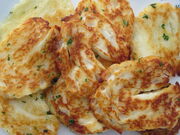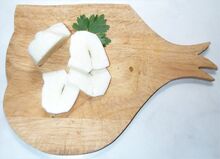
|
This page uses content from Wikipedia. The original article was at Halloumi. The list of authors can be seen in the page history. As with WikiCheese, the text of Wikipedia is available under the Creative Commons Attribution-Share Alike License 3.0 (Unported) (CC-BY-SA). |
Halloumi (Greek χαλούμι, Turkish hellim, Arabic حلوم ḥallūm) is a Cypriot semi-hard, unripened brined cheese made from a mixture of goats' and sheep milk, and sometimes also cows' milk.[1][2][3][4] It has a high melting point and so can easily be fried or grilled. Halloumi is set with rennet and is unusual in that no acid or acid-producing bacterium is used in its preparation.[5]
Halloumi is popular in Cyprus, Greece, and the rest of the Middle East.[6][7]
Cypriot halloumi[]

Grilled Halloumi cheese
Halloumi cheese originated in Cyprus[6] and was initially made during the Medieval Byzantine period,[8] subsequently gaining popularity throughout the rest of the Middle East region.
The cheese is white, with a distinctive layered texture, similar to mozzarella and has a salty flavor. It is stored in its natural juices with salt-water and can keep for up to a year if frozen below −18 °C (0 °F) and defrosted to +4 °C (39 °F) for sale. It is often garnished with mint to add to the taste. Traditionally, the mint leaves were used as a preservative, this practice arising from the serendipitous discovery that Halloumi kept better and was fresher and more flavorsome when wrapped with mint leaves. In accordance with this tradition, many packages of halloumi contain fragments of mint leaves on the surface of the cheese.

Fresh sliced halloumi.
The cheese is often used in cooking and can be fried until brown without melting, owing to its higher-than-normal melting point. This makes it an excellent cheese for frying or grilling (e.g. in saganaki) or fried and served with vegetables, as an ingredient in salads. Cypriots like eating halloumi with watermelon in the warm months, and as halloumi and lountza - a combination of halloumi cheese and either a slice of smoked pork, or a soft lamb sausage.
The resistance to melting comes from the fresh curd being heated before being shaped and placed in brine.[9] Traditional halloumi is a semicircular shape, about the size of a large wallet, weighing 220-270 g. The fat content is approximately 25% wet weight, 47% dry weight with about 17% protein. Its firm texture when cooked causes it to squeak on the teeth when being chewed.
Traditional halloumi is made from unpasteurized sheep's and goat's milk. Many people also like halloumi that has been aged; kept in its own brine, it is much drier, much stronger and much saltier. This cheese is very different from the milder halloumi that Western chefs use as an ingredient.
Although it is of rather disputed origin due to the mixed cultures in the Levant and East Mediterranean, halloumi is currently registered as a protected Cypriot product within the US (since the 1990s) but not yet the EU. The delay in registering the name halloumi with the EU has been largely due to a conflict between dairy producers and sheep and goat farmers as to whether registered halloumi will contain cow’s milk or not and if so, at what ratios with sheep and goat’s milk.[10][11] If it is registered as a PDO (Protected designation of origin) it will receive similar status as 600 or so other agricultural products such as feta and parmesan cheese.
Egyptian hâlûm[]
Egyptian hâlûm, which is similar to Cypriot "halloumi" but is essentially a different cheese, is eaten fresh or brined and spiced, which is called mishsh.
Etymology[]
The name 'halloumi' probably comes from Arabic [12][13][14].
Nutritional facts[]
100 g of commercially produced packaged halloumi has a typical composition of:[15]
| Fat | 26 g |
|---|---|
| Carbohydrate | 1.8 g |
| Protein | 22 g |
| Energy | 322 kcal |
References[]
- ↑ Gibbs, Paul; Ria Morphitou, George Savva.. "Halloumi: exporting to retain traditional food products". British Food Journal 106 (7): 569–576. doi:10.1108/00070700410545755. http://www.emeraldinsight.com/Insight/ViewContentServlet?Filename=Published/EmeraldFullTextArticle/Articles/0701060706.html. Retrieved 2007-12-14.
- ↑ "Cyprus - Cultural life - Daily life and social customs - halloumi cheese.". www.britannica.com. http://www.britannica.com/EBchecked/topic/148573/Cyprus. Retrieved 2009-06-16. "Geography has left Cyprus heir to numerous culinary traditions—particularly those of the Levant, Anatolia, and Greece — but some dishes, such as the island’s halloumi cheese are purely Cypriot"
- ↑ Ayto, John (1990). The glutton's glossary: a dictionary of food and drink terms. Routledge, 133. ISBN 0-415-02647-4. “Haloumi, or halumi, is a mild salty Cypriot cheese made from goat's, ewe's, or cow's milk.”
- ↑ Dew, Philip – Reuvid, Jonathan - Consultant Editors (2005). Doing Business with the Republic of Cyprus. GMB Publishing Ltd, 46. ISBN 1-905050-54-2. “Cyprus has managed to secure EU recognition of halloumi as a traditional cheese of Cyprus ; therefore no other country may export cheese of the same name”
- ↑ Charles O'Connor. Traditional Cheesemaking Manual. International Livestock Centre for Africa.
- ↑ 6.0 6.1 Robinson, R. K. – Tamime, A. Y. (1991). Feta and Related Cheeses. Woodhead Publishing, 144. ISBN 1-85573-278-5. “Halloumi is a semi-hard to hard, unripened cheese that, traditionally, is made from either sheep's milk or goat's milk or a mixture of the two. Although the cheese has its origins in Cyprus, it is widely popular throughout the Middle East, and hence many countries have now become involved with its manufacture.”
- ↑ Allen, Gary J. (2007). The herbalist in the kitchen. University of Illinois Press, 212. ISBN 0-252-03162-8. “Haloumi (sometimes spelled Halloumi) is a brine-cured cheese from Greece and Cyprus containing chopped mint.”
- ↑ Goldstein, Darra – Merkle, Kathrin – Parasecoli, Fabio – Mennell, Stephen - Council of Europe (2005). Culinary cultures of Europe: identity, diversity and dialogue. Council of Europe, 121. ISBN 92-871-5744-8. “Most culinary innovations in the Cypriot cuisine occurred during the Byzantine era Experimentation with dairy products resulted in the now-famous halloumi and feta cheese.”
- ↑ Galarneau, Andrew Z (2008-09-14). "Elements: Halloumi -One ingredient, one dish". The Buffalo News. Archived from the original on 2012-07-24. http://archive.is/snzF. Retrieved 2008-09-15.
- ↑ Application for the name ‘halloumi’ to go to EU in early 2007, Cyprus Mail archive article - Saturday, September 2, 2006 [1]
- ↑ Saoulli, Alexia (March 3, 2007). "Halloumi bickering threatens EU application". Cyprus Mail. Archived from the original on 2007-08-13. http://web.archive.org/web/20070813101718/http://www.cyprus-mail.com/news/main.php?id=31047&archive=1. Retrieved 2007-03-04.
- ↑ Oxford English Dictionary
- ↑ Andriotis et al., Λεξικό της κοινής νεοελληνικής
- ↑ P. Papademas, "Halloumi Cheese", p. 117ff, in Adnan Tamime, ed., Brined Cheeses in the Society of Dairy Technology series, Blackwell 2006, ISBN 1-4051-2460-1
- ↑ "Nutritional information on halloumi cheese". Alambra Dairy Products. http://www.petroubros.com.cy/english/products_haloumi.shtm. Retrieved 2008-05-07.